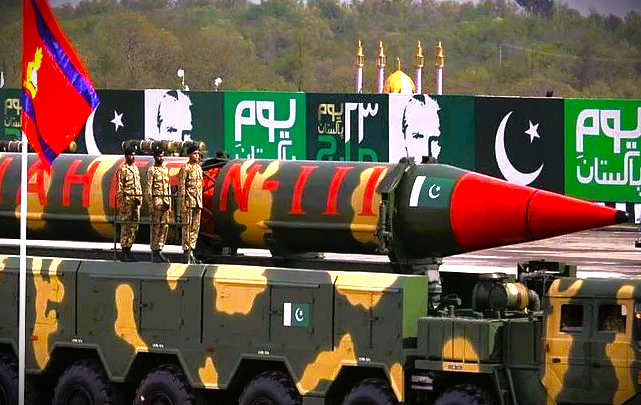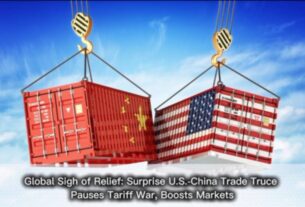In the tense aftermath of its crushing military setback in the recently-paused Operation Sindoor, Pakistan is racing down a perilous new path. A classified U.S. intelligence report has exposed Islamabad’s desperate bid to regain strategic footing not through diplomacy, but through nuclear brinkmanship, covert weapons deals, and a dangerously deepening alliance with China.
What’s unfolding is more than a military response, it’s a geopolitical gambit with far-reaching consequences.
From Battlefield Loss to Nuclear Obsession
Pakistan’s conventional forces were overwhelmed during Operation Sindoor, which saw Indian military power on full display. But rather than recalibrating through peace or reform, Islamabad has adopted a far more ominous strategy: the rapid expansion of its tactical nuclear weapons arsenal, designed specifically for use on the battlefield in a potential future war with India.
Unlike strategic nukes aimed at cities, these smaller, portable warheads are intended for frontline deployment making them more “usable” in real-world combat. And that, U.S. officials warn, is precisely what makes them so dangerously destabilizing.
The shift marks a chilling doctrinal transformation. Pakistan no longer seeks parity; it seeks deterrence through unpredictability.
China’s Hidden Hand: Supplier, Strategist, and Silent Stakeholder
Central to this nuclear acceleration is Beijing. China, Pakistan’s long-standing “iron brother,” is now more than a diplomatic ally, it is the engine behind Islamabad’s post-defeat resurgence.
According to the intelligence report, Pakistan is secretly sourcing sensitive nuclear technologies via a covert procurement network stretching across China, Turkey, Hong Kong, Singapore, and the UAE. This sprawling supply chain is designed to bypass global non-proliferation protocols, allowing Pakistan to modernize its warheads and nuclear command systems in the shadows.
But why is China so invested?
Analysts believe Beijing is using Pakistan not just as a strategic buffer against India but as a real-world testing ground for its own advanced military systems. From fighter jets to missile defense platforms, China is leveraging joint operations and exercises to trial its arsenal under combat-simulated conditions.
A prominent example: the PLA-PAF joint air exercise in November 2024, which U.S. officials say was a dress rehearsal for coordinated action in a potential future conflict.
Pakistan’s Dangerous Dependency
Economically battered and diplomatically isolated, Pakistan has become alarmingly dependent on Beijing not just for military aid, but for financial lifelines, trade routes, and diplomatic cover. The intelligence report warns that this dependency has effectively outsourced Islamabad’s foreign and defense policy to China, with troubling implications for South Asia’s balance of power.
In the event of renewed conflict with India, Beijing may not stay on the sidelines. The possibility of China directly influencing or even participating in future Indo-Pak skirmishes is no longer hypothetical, it’s now a real and growing risk.
Beyond India: A Nation Under Siege
While India remains at the heart of Pakistan’s military strategy, Islamabad is simultaneously waging battles on multiple fronts. Domestic insurgencies, particularly from the Tehreek-e-Taliban Pakistan (TTP) and the Baloch Liberation Army (BLA), have escalated sharply, killing over 2,500 civilians and security personnel in 2024 alone.
Compounding the crisis, relations with neighbors are in tatters. Border skirmishes with Iran following retaliatory airstrikes in 2024 and air raids inside Afghanistan in March 2025 have inflamed regional tensions. Islamabad accuses the Afghan Taliban of harboring TTP militants, while its fragile talks with Tehran remain marred by mistrust.
In short: Pakistan is a nuclear-armed nation under siege, seeking salvation through arms and alliances instead of diplomacy.
The World’s Most Dangerous Arms Race?
The report paints a stark picture: a defeated Pakistan, backed by a rising China, fueling a fast-paced, opaque nuclear buildup just miles from Indian borders. With tactical nukes now in the mix, the once-clear line between conventional and nuclear warfare is dangerously blurred.
This isn’t just an arms race, it’s a strategic time bomb.
India, now firmly at the center of Pakistan’s war planning, must recalibrate its own defense posture. Meanwhile, U.S. and international efforts to contain proliferation in South Asia are being tested like never before.
Conclusion: A Flashpoint in the Making
What began as a regional military clash is fast mutating into a multi-front geopolitical confrontation. Pakistan’s nuclear gamble turbocharged by Chinese backing and cloaked in clandestine operations has created a volatile new chapter in South Asia’s security narrative.
The stakes have never been higher.
If global powers fail to contain this dangerous alignment, the next Indo-Pakistan conflict may not end on the battlefield; it could end in a nuclear shadow that engulfs the entire region.




